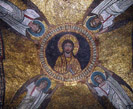In the yoga practices mandala can be a support for meditation or an image that must be internalized through mental absorption. This image organizes the inner energies and forces of the practitioner and puts them in relationship with his ego. Generally speaking a mandala is a geometrical form - a square or a circle - abstract and static, or a vivid image formed of objects and/or beings. In our dreams the mandala indicates the phenomenon of centering the individual psychic in which the ego reconsiders its (dominant) position through the assimilation of the collective unconscious contents (symbols or archetypal images). In modern dreams mandala can be a sophisticated electronic device - an electronic watch or a sophisticated circular machinery. Often the UFOs seen on the sky are also mandala symbols.
In the Jungian therapy, which includes the living experience of the collective unconscious contents, the spontaneous drawing of mandalas is used. There are a lot of illustrations that testify this technique practiced by Jung himself. -- |
© Carl Jung Resources, 2011. |

